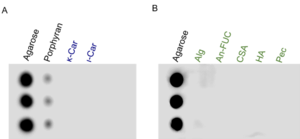CAZypedia celebrates the life of Senior Curator Emeritus Harry Gilbert, a true giant in the field, who passed away in September 2025.
CAZypedia needs your help!
We have many unassigned pages in need of Authors and Responsible Curators. See a page that's out-of-date and just needs a touch-up? - You are also welcome to become a CAZypedian. Here's how.
Scientists at all career stages, including students, are welcome to contribute.
Learn more about CAZypedia's misson here and in this article. Totally new to the CAZy classification? Read this first.
Carbohydrate Binding Module Family 101
This page has been approved by the Responsible Curator as essentially complete. CAZypedia is a living document, so further improvement of this page is still possible. If you would like to suggest an addition or correction, please contact the page's Responsible Curator directly by e-mail.
| CAZy DB link | |
| https://www.cazy.org/CBM101.html |
Ligand specificities

The first characterized member in the CBM101 family is WfCBM101 [1]. The CBM WfCBM101 bound to agarose and displayed a weak affinity to porphyran (Fig. 1). It was incapable of binding to the other polysaccharides that were examined, including κ-carrageenan, ι-carrageenan, alginate, sulfated fucan, chondroitin sulfate A sodium salt, hyaluronic acid, and pectin. Furthermore, WfCBM101 bound to agarose tetrasaccharide, but not to porphyran tetrasaccharide. It was reported porphyran consists of approximately 30% structural units of agarose [2]. It is thus speculated that the weak affinity of WfCBM101 for porphyran is attributed to the structural heterogeneity of porphyran.
Structural Features
An AlphaFold2 model predicts that WfCBM101 has a β-sandwich fold.
Functionalities
To evaluate the feasibility of WfCBM101 as a tool in the in situ investigation of porphyran, a fluorescent probe was constructed by fusing WfCBM101 with a green fluorescent protein. The in situ visualization of agarose in the red alga Gelidium amansii was realized by utilizing the fluorescent probe [1]. Taking WfCBM101 as the query sequence, 15 modules were retrieved from the NCBI database by the BLASTP program (E-value < e-5). There are eight modules adjacent to catalytic domains which are divided into the GH16_16 subfamily or GH86 family. According to the CAZy database, the [[GH16]_16 subfamily and GH86 family have members that degrade agarose. This implies that these eight modules might bind to agarose; however, this requires further investigation.
Family Firsts
- First Identified
The first member WfCBM101 is a component of a GH86 β-agarase (unpublished data) from a marine bacterium Wenyingzhuangia fucanilytica CZ1127T [3].
- First Structural Characterization
No experimentally determined three-dimensional structure has been solved in this CBM family.
References
- Mei X, Zhang Y, Jiang X, Liu G, Shen J, Xue C, Xiao H, and Chang Y. (2024). Discovery and characterization of a novel carbohydrate-binding module: a favorable tool for investigating agarose. J Sci Food Agric. 2024;104(5):2792-2797. DOI:10.1002/jsfa.13164 |
- Chi WJ, Chang YK, and Hong SK. (2012). Agar degradation by microorganisms and agar-degrading enzymes. Appl Microbiol Biotechnol. 2012;94(4):917-30. DOI:10.1007/s00253-012-4023-2 |
- Error fetching PMID 27220912: